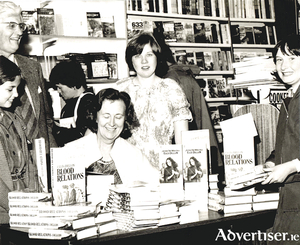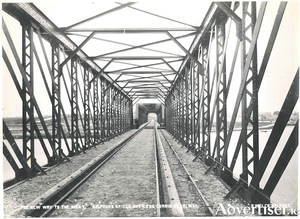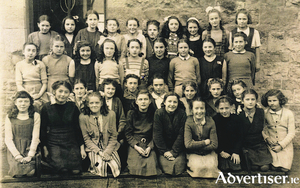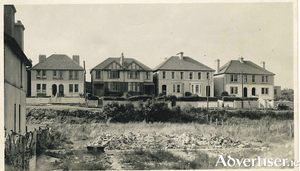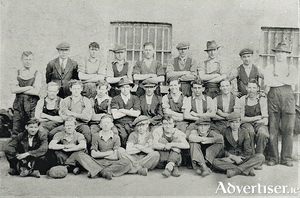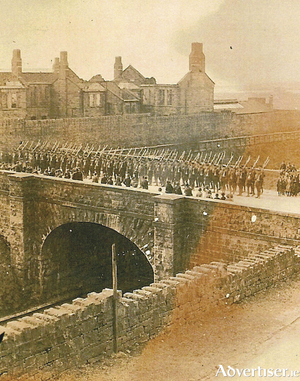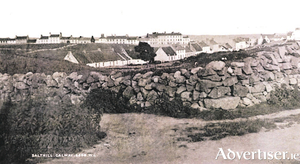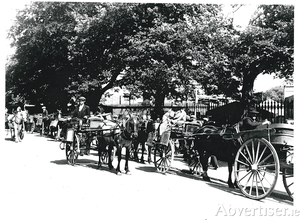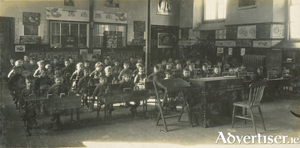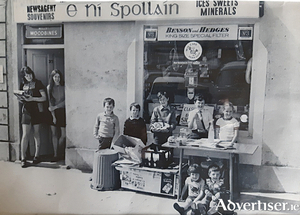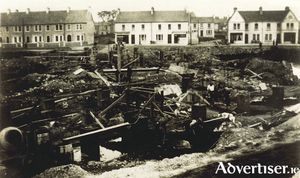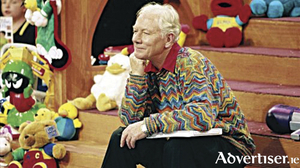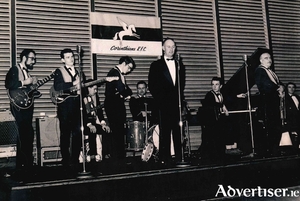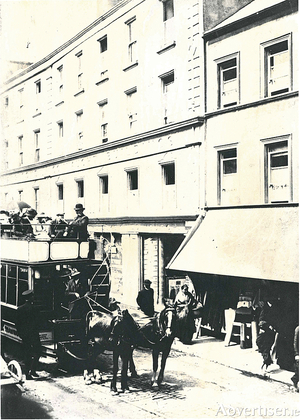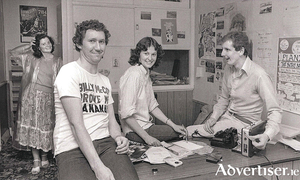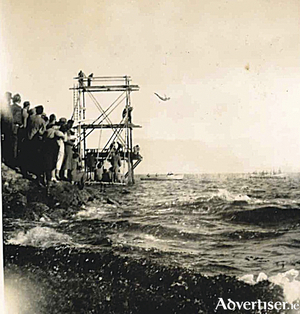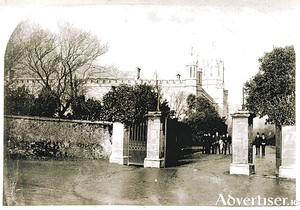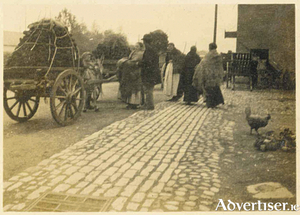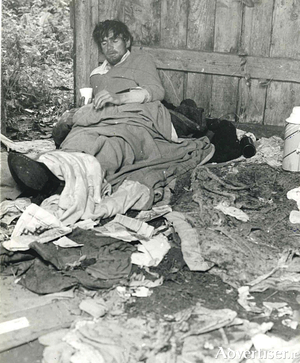Celebrating Eilís Dillon
Thu, Mar 05, 2020
Eilís Dillon was born on March 7, 1920, in Galway. Her parents were Professor Tom Dillon and Geraldine Plunkett, who was a sister of Joseph Mary Plunkett. They were very republican and were forced to move a number of times. They lived for a time in Daingean House and later in Barna for a few years. Eilís went to Barna National School where she became fluent at Irish, later to the Presentation, and later still to the Ursuline Convent in Sligo. She worked for a while in the hotel business.
Read more ...The White Bridge
Thu, Feb 27, 2020
This photograph of the Galway-Clifden railway bridge over the river was taken from the west side, looking towards Bohermore. It was built in 1894 and consisted of three spans of 150 feet with a 21 feet span in the centre. This centre one was a lifting one on the bascule principle to allow for navigation of boats and steamers from the sea and canal to the lake.
Read more ...Sixth class, The Mercy, 1948
Thu, Feb 20, 2020
One hundred and eighty years ago, the Sisters of Mercy came to Galway for the first time, to a house in Lombard Street, to devote themselves to works of mercy among the poor. The great Catherine McAuley was one of the first three nuns to come here, the others being Mother M Teresa White and Mother N Catherine Leahy.
Read more ...The cinema site, Salthill
Thu, Feb 13, 2020
Lenaboy is the name of one of the townlands of Salthill. It derives either from the Irish Léana Buí, the yellow fields/land or Léana Báite, the sunken or drowned land. The latter explanation is the most likely as we look at this photograph of “The Cinema Site” taken from the main road at Kingshill in Salthill. It was so-called locally because James Stewart & Co tried to build a cinema there in the 1940s. Unfortunately, because of the boggy nature of the ground, the pylons they were sinking in order to put in a foundation kept sinking and disappearing and so the project was abandoned. In the 1960s an enormous amount of filling was gradually put into the site, and eventually, John King built a block of apartments there.
Read more ...Some Galway Foundry staff
Thu, Feb 06, 2020
At the beginning of the last century, Beatty Brothers had a foundry in Mill Street. In 1913, they advertised ‘a desire to announce that their factory was fitted with a first-rate plant for the manufacture of spades and shovels. Tons of them were sold last season’.
Read more ...Dún Uí Mhaoilíosa, a brief history
Thu, Jan 23, 2020
In 1852, the British war department bought lands at Renmore with the idea of building a new military barracks to replace the existing ones in the city, the Shambles and the Castle Barracks. These two building complexes were getting old and deteriorating and needed to be replaced. In 1880, the new barracks were built at Renmore. They were occupied by the Royal Irish Fusiliers and later by the Connaught Rangers.
Read more ...Lenaboy Avenue, c1890
Thu, Jan 16, 2020
This photograph was taken from the top of Dalysfort Road (which seems to have been little more than a track at the time) and shows Lenaboy Avenue at the bottom of the hill and part of the main Salthill Road in the distance. Most of the buildings in the avenue were part of the Whaley Estate. Many of the occupants were fishermen and many of them had seaweed rights which were quite valuable at the time. The avenue was a main pathway to the shore for people living inland at the time.
Read more ...An old Galway taxi rank
Thu, Jan 09, 2020
The word ‘hackney’ derives from the place name Hackney in London which supplied horses from the surrounding meadows. An ordinance for the regulation of hackney coachmen in London was approved by the English Parliament in 1654 to “remedy the many inconveniences [that] do daily arise by reason of the late increase and great irregularity of coaches and coachmen.” The first hackney carriage licences date from 1662. Licences applied literally to horse-drawn carriages, later modernised to ‘hansom cabs’ that operated as vehicles for hire.
Read more ...Seven wonders
Thu, Dec 26, 2019
I was asked a question some time ago that stopped me in my tracks, “What, for you, would be the seven wonders of Galway?” It made me think long and hard and I decided to draw up a list. It might be the sunrise on the bay on December mornings, the sunset on the bay on November evenings, the atmosphere on the streets, hearing Irish spoken on the streets, the Druid, An Taidhbhearc, the Pádraic Ó Conaire statue, the tower at Blackrock, the Saturday market, the River Walk, Lynch’s Castle, the Arts Festival, Galway oysters, the Garden of Remembrance, Cúirt, and so on. All of these are important to me, a source of joy to me, parts of the fabric that make up this city I am proud to live in.
Read more ...Hynes’ shop, a brief history
Thu, Dec 19, 2019
In the 1920s a family named Healy from College Road built three houses on Forster Street. The owner of the first house (next door to Harry Clare’s stonemason’s yard) was a Jewish man named Isaac. He did piano repairs and his daughter was an opera singer. He worked from a shed at the back of the house. In the 1930s he sold the house to John McDonagh from Glann near Oughterard, who was married to Mary Anne Spellman from Fermoyle. They opened a grocery shop and a lending library.
Read more ...Father Griffin Road
Thu, Dec 05, 2019
This view of part of Father Griffin Road was taken from Father Burke Road c1955. In the foreground you can see the land being levelled and prepared for the building of the Technical School.
Read more ...My mother had an affair with Gay Byrne
Thu, Dec 05, 2019
My mother, who religiously listened to the Gay Byrne Show, operated a kind of censorship. There were certain topics she did not want me to hear. For two hours, five days a week, she would shut the kitchen door, and listen to Gay with the volume turned down. On one occasion I came into the room. She asked: “What do you want?” Nobody needs an excuse to go into one’s kitchen, so I’d rather indignantly replied: “Nothin’.” “Well,” she said, “I’m busy.” And that meant scram.
Read more ...The Western All-Stars, 1963
Thu, Nov 28, 2019
After the war, there was a bit of a building boom of dance halls around the country. Radio had introduced popular music to the general public and more and more people wanted to move to the music, so dance bands began to form. Some of those in Galway were Des Fretwells’ Band, Maxie Dooley’s Musicmakers, The Bill Keaveney Orchestra, and Gerry Cahill’s Dance Band. They played the popular music of the day, were mostly seated on stage and reading the music from stands in front of them. Then along came Bill Haley and rock and roll and everything changed. The showbands had arrived. Music stands were forgotten, musicians played standing up and literally began to move with the times.
Read more ...B Connolly Sons & Co, The Connaught Buildings
Thu, Nov 21, 2019
The Connaught Buildings in Mainguard Street were established in 1861. The complex formed the business of Bartley Connolly and Sons. He advertised extensively as “By Special Appointment, Purveyor to HRH the Duke of Edinburgh; and to his excellency The Lord Lieutenant, and Chief Executive for Ireland.” They were major wine importers, spirit merchants, family grocers, and Italian warehousemen.
Read more ...Independent Radio Galway
Thu, Nov 14, 2019
In 1978, RTE was on strike for some time which meant the repair shop in O’Connor TV had nothing to do, so John O’Sullivan and friends built a 30-watt transmitter and this prompted Tom O’Connor, John O’Sullivan, and Eamonn Geary to get together and set up a pirate radio station called Independent Radio Galway. Their studio was in an attic in the courtyard behind Cahill’s shop in William Street, and when this space became too small, they moved to a larger room over Garavans, where Johnny Waldron’s Joke Shop is today. The 199 metre aerial ran from the top of Glynns to the top of Gleesons. Their furniture consisted of two tables, a few chairs, the home-made transmitter, two turntables, and a few minor pieces of equipment.
Read more ...Diving at Blackrock
Thu, Nov 07, 2019
Up until the mid-19th century, there was a cluster of thatched cottages at Blackrock. on the Night of the Big Wind [January 6, 1839] these were literally blown away by the ferocity of the storm and the tide and most of the occupants had to move inland. They were mostly fishermen and there had always been a tradition of fishing in the area. Blackrock was also a favourite place for men bathing, and in 1885, Mr Moon and some of his friends decided to place a springboard there. Unfortunately they did not have ‘planning permission’ from the owner of the land, Colonel O’Hara, and he had the board removed and made it difficult for the bathers to get to the rock at all. It ended up in court and the urban council stepped in and signed a lease giving a public right of way to the bathing area.
Read more ...Diving at Blackrock
Wed, Nov 06, 2019
Up until the mid-19th century, there was a cluster of thatched cottages at Blackrock. on the Night of the Big Wind [January 6, 1839] these were literally blown away by the ferocity of the storm and the tide and most of the occupants had to move inland. They were mostly fishermen and there had always been a tradition of fishing in the area. Blackrock was also a favourite place for men bathing, and in 1885, Mr Moon and some of his friends decided to place a springboard there. Unfortunately they did not have ‘planning permission’ from the owner of the land, Colonel O’Hara, and he had the board removed and made it difficult for the bathers to get to the rock at all. It ended up in court and the urban council stepped in and signed a lease giving a public right of way to the bathing area.
In April, 1904, the urban council sought tenders for the erection and maintenance of the springboard at Blackrock. This structure was quite primitive and consisted of a wooden walkway with the board at the end, all supported by some metal poles. It was eventually replaced by this more elaborate structure much further out into the water which we see in our photograph today (which was kindly given to us by Cliona Clarke). Swimming galas were held here, usually under poor conditions, the idea of a swimming pool with lanes was a pipe dream then.
Read more ...Queen’s College, Galway/UCG/NUIG, one hundred and seventy years
Thu, Oct 31, 2019
The history of Galway as an educational centre dates from the close of the Middle Ages. The Free School of Galway became so celebrated for its classical learning that it had more than 1,200 students from all over the country attending its courses under Alexander Lynch in 1615, when it was suppressed by King James I.
Read more ...The Turf Market at Raven Terrace
Thu, Oct 24, 2019
I am afraid I made a bags of this column two weeks ago when I printed the wrong photograph which did not relate to the printed text. So this week I am giving you the text again, this time with the appropriate photograph.
Read more ...Galway Simon, the early years
Wed, Oct 16, 2019
The Simon Community takes its name from Simon of Cyrene who helped Jesus carry the cross. It was founded in London in 1963 by Anton Wallich-Clifford and a branch was set up in Dublin in 1969. Early in 1979, Frank O’Leary OFM spoke at a meeting in Galway entitled Poverty in Ireland about the work of Simon in providing shelter, friendship, and acceptance to homeless people. Two psychology students, Margaret Brehony and Kathy O’Grady, drew attention to the fact that there were rough sleepers in Galway too.
Read more ...